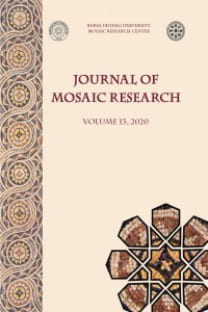The Tunisian Mosaic Heritage: General Diagnosis
Tunisian Roman mosaics, conservation, enhancement, practices requirements,
___
- Bairem-Ben Osman 1980 W. Bairem-Ben Osman, ‘‘Catalogue des mosaïques de Carthage’’, Thèse de doctorat de 3ème cycle, Université d’Aix-en-Provence.
- Blanchard-Lemée et al. 1995 M. Blanchard-Lemée - M. Ennaïfer - H. Slim - L. Slim, Sols de la Tunisie romaine, Paris.
- Ennaïfer 1976 M. Ennaïfer, La cité d’Althiburos et l’édifice asclepieia, Tunis.
- Foucher 1960 L. Foucher, Inventaire des mosaïques –Feuille n°57 de l’Atlas archéologique, Sousse, Tunis.
- Gozlan et al. 2001 S. Gozlan - N. Jeddi - V. Blanc-Bijon - A. Bourgeois, Recherches Archéologiques franco-tunisienne à Acholla. Les mosaïques des maisons du quartier central et les mosaïques éparses, Paris.
- Hajji 2009 J. Hajji, ‘‘Conflits et Amours mythiques représentés sur des mosaïques de l’Afrique Proconsulaire au Bas-Empire (fin du IIIème - début du Vème siècle)’’, Thèse de doctorat, Université-Lumière Lyon.II, Lyon.
- Hajji 2011 J. Hajji, ‘‘Chrysès et Agamemnon sur une mosaïque de Neapolis. Quelques réflexions Iconographiques’’, MeditArch 24, 93-102.
- Hajji 2013 (2017) J. Hajji, ‘‘La fuite des Enéades sur un emblema de Carthage’’, Musiva 10, 15-52.
- Hajji 2017 J. Hajji, ‘‘Le plongeon d’Ino dans la mer sur un emblema de Carthage’’, Africa (T) 24, 135-146.
- Marc-André 2018 R. Marc-André, Le commerce légal et illégal de biens culturels vers et à travers l’Europe : faits, conclusions et analyse juridique, Genève.
- Picard 1980 G. C. Picard ‘‘De la Maison d‘Or de Néron aux thermes d‘Acholla’’, Mon Piot 63, 63-104.
- Slim et al. 1996 H. Slim - C. Duliere - M. A. Alexander - S. Ostrow - J. G. Pedley - D. Soren, Corpus des mosaïques de Tunisie. Vol.III-Thysdrus, Eljem, Fascicule 1, Quartier sud-ouest, Tunis.
- Slim - Fauqué 2001 H. Slim - N. Fauqué, La Tunisie antique de Hannibal à Saint Augustin, Paris.
- Yacoub 1995 M. Yacoub, Splendeurs des mosaïques de Tunisie, Tunis.
- Yacoub 1996 M. Yacoub, Le musée du Bardo (Départements antiques), Tunis.
- ISSN: 1309-047X
- Yayın Aralığı: 1
- Başlangıç: 2008
- Yayıncı: Ululdağ Üniversitesi, Mozaik Araştırlmaları Merkezi
Nadezhda A. DUBOVA, Natalia A. KOVALEVA, Galina E. VERESOTSKAYA, Anatolij M. YUMINOV
Nissma BOUZOUBAA, Abdelilah DEKAYİR
Miguel PESSOA, Ana Luísa Ravara MENDES, Elsa Simões SIMÕES, Sónia VICENTE
Amir GORZALCZANY, Baruch ROSEN
